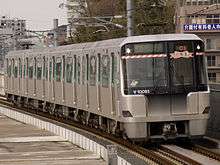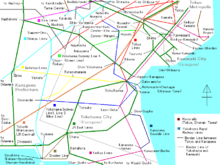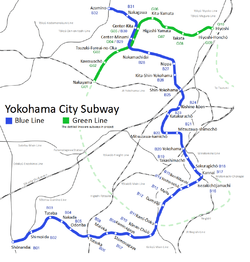Yokohama Municipal Subway
 | |||
| Overview | |||
|---|---|---|---|
| Native name |
横浜市営地下鉄 Yokohama-shiei chikatetsu | ||
| Locale | Yokohama, Japan | ||
| Transit type | Rapid Transit | ||
| Number of lines | 2 (Blue & Green) | ||
| Number of stations | 42 | ||
| Website |
www | ||
| Operation | |||
| Began operation | December 16, 1972 | ||
| Operator(s) | Yokohama City Transportation Bureau | ||
| Technical | |||
| System length | 53.4 km (33.2 mi) | ||
| Track gauge | 1,435 mm (4 ft 8 1⁄2 in) | ||
| |||
Yokohama Municipal Subway (横浜市営地下鉄 Yokohama-shiei chikatetsu) is the metro network in the city of Yokohama, Japan, south of Tokyo In Kanagawa pref. It is operated by Yokohama City Transportation Bureau, and is operated as two lines, though 3 continuous lines exist.

Lines

| Symbol | Line | Name | First section opened |
Last ex- tension |
Length km/miles |
Stations |
|---|---|---|---|---|---|---|
| Line 1 | Blue Line | 1972 | 1999 | 19.7 km (12.2 mi) | 17 | |
| Line 3 | 1985 | 1993 | 20.7 km (12.9 mi) | 16[Note 1] | ||
| Line 4 | Green Line | 2008 | - | 13.1 km (8.1 mi) | 10 | |
| Total: | 53.5 km (33.2 mi) | 42 | ||||
The Yokohama Municipal Subway lines are line 1, line 3 and 4. Lines 1 and 3, connecting Shonandai station and Azamino station, are operated integrally, nicknamed the Blue Line. Line 4 Hiyoshi station -Nakayama station is nicknamed the Green Line. Upon the opening of this line on March 30, 2008, the Blue Line and Green Line monikers came into official use.
Blue Line
The Blue Line (line 1 and line 3) is operated as an integral route of 40.4 kilometres (25.1 mi) between Shonandai station and Azamino station. The Blue Line is Japan's second-longest subway line, after the 40.7 km (25.3 mi) Oedo Line on the Toei Subway in Tokyo.
In addition, there is a drawing plan from Azamino station to the shinYuri-Oka station ehicle, all seats were priority seats, but since April 1, 2013, it was no longer a priority seat for all seats, so the "Yuzuriai sheet" was created for each vehicle. As a result, in the vicinity of the Yuzuriai seat, the mobile phone with the power supply is prohibited, and the other seats are set in manner mode like other companies. In the car, "turn off the mobile phone" broadcast is also performed, because the number of announcements is few, and the notice of the car is decreasing than before, it is not completely thorough, and because a lot of passengers were actually using the cell phone in the train,
In July 2011, the "mobile phone power off area" was set up in each vehicle, and it was decided to officially ban the use of mobile phones except for calls outside the area.
Timetable for the operation schedule of the wrapping vehicle is published on the official website of the Transportation Bureau. In the blue line, for the implementation of one-man operation, the operation of the ATO (automatic Train operation device) has been started since January 20, 2007. At the home of the Blue Line station, the installation of the home door was underway and the operation began on September 15, 2007 at all stations. It was originally scheduled to be operated sequentially from Azamino station toward Shonandai station in February, but it was changed to start in April. Conventionally, in the blue line is not carried out the departure instructions by the departure Bell Peek at the first train and Ching, the conductor had to depart by closing the door to blowing the hand whistle, the conductor from the flight will not be by one-man operation, We introduced the full-day operation of the departure sign sound from November 27, 2007.
To clarify the distinction by direction, the departure sign sound depends on the destination. The one-man operation on the Blue Line began on December 15, 2007, which was the 35th anniversary of its opening. The driver monitors the passengers on the passenger's seat and opens and closes the door. By the implementation of a one-man operation, the cost of approximately 9 billion yen, which is a labor cost of 133 conductors, is reduced, and the cost of 100 million yen per year is increased for the maintenance and management of the home door, and the deduction is estimated to reduce expenses by approximately 800 billion yen. On the other hand, the advertisement on the wall of the station was hard to see because of the home door, and the advertisement cancel the advertisement contract one after another, and the new problem of decrease in the advertising revenue also caused it.
In addition, the rapid operation has been started on July 18, 2015.
Green Line
The Green Line (line 4) opened on March 30, 2008 at Hiyoshi Station-Zhongshan station, operating distance 13.0 km (total extension distance 13.1 km).
It was originally scheduled to open in 2007. The opening was postponed for one year due to the difficulty of expropriation of land in the vicinity of Hiyoshi honcho from Hiyoshi station to Hiyoshi-Honmachi station, and the agreement of the local right person was not obtained. As for the Green Line, the home door was operated from the time of opening, and the installation rate of the home door was 100% in the Yokohama Municipal Subway along with the Blue Line. In the Green Line, one-man driving and the departure sign sound are introduced at the time of opening. The sound and the departure sign of the home door are the same as the Blue Line and are used.
Planned extensions
Blue Line
An extension of the Blue Line (line 3) is being studied from Azamino station to the new Yuri-Oka station in Kawasaki City.
Green Line
The Green Line was built as part of a larger master plan to construct the Yokohama Ring Railway. The Ring Railway is a proposed C-shaped line that connects to the Yokohama station, which is connected to the Motomachi-Chinatown station via Hiyoshi station, Zhongshan Station, Futamatagawa Station, Higashi-Totsuka station, Kami-Ooka station and Negishi station from Tsurumi station.
Canceled Line 2
Line 2 was planned as a 11.4 km (7.1 mi) line from Kanagawa Shin-machi station, Yokohama Station East, Wisteria Town, Yoshino-cho Station and Takigashira-machi to the folding screen. Although it had been considered as a bypass line for the congestion easing of the Keikyu main line in parallel, the need for construction was obviated when the Keikyu line increased its capacity. In 2004, the Yokohama Minatomirai Railway Company opened the Minatomirai Line on a slightly different path.
The original plan for Line 3 called for it to connect Honmoku and Katsuta, and a portion of the tunnel toward Honmoku was completed from the Kannai station yard. In 1975, construction of the line caused criticism from the port industry; groups such as the Yokohama Port Union Association and the Yokohama Shipowners' Association claimed thatr subway construction was increasing traffic around the port and affecting its usefulness, asking for the postponement of the project. As a result of the ensuing negotiations, the construction started after completion of the Tokyo Metropolitan Expressway Yokohane Line Yamashita Interchange and Yamashita Nagatsuta line. When the MM21 plan was announced in 1981, the construction of the line to Honmoku was frozen; the corresponding business license was withdrawn in 1988, sealing the project's fate.
Station numbering
Numerical designations for the stations on the Blue Line were introduced in 2002, coinciding with the city hosting the finals of the 2002 FIFA World Cup and the subway's 30th anniversary, starting from Shonandai station (1) to Azamino station (32). With 32 stations on the line and 32 teams in the World Cup, each station was themed after a country. Alphabetical designations were added when the Green Line opened. The Blue Line stations are B01 through B32, while G01 on the Green Line is Zhongshan Station. At two stations—Center South Station and Center North Station—where both lines overlap, a different station number is attached to each route.
Adult fares
Normal passenger fares (for children half-price and IC cards are rounded down less than 1 yen, rounded up less than 10 yen for ticket purchases). Revised on June 1, 2014, the same day.
| About a Km | Fare (yen) | |
|---|---|---|
| card | Ticket | |
| ~3 | 206 | 210 |
| 4~7 | 237 | 240 |
| 8~11 | 267 | 270 |
| 12~15 | 299 | 300 |
| 16~19 | 329 | 330 |
| 20~23 | 360 | 360 |
| 24~27 | 390 | 390 |
| 28~31 | 422 | 430 |
| 32~35 | 453 | 460 |
| 36~39 | 483 | 490 |
| 40~42 | 515 | 520 |
| 44~ | 545 | 550 |
Ticket
One day ticket
"One-day subway ticket" (Adult 740 yen), "bus and subway Common day ticket" (adult 830 yen) and have been released (both children are half-price, rounded up less than 10 yen).
"Vouchers that can be used repeatedly"
Tickets It can be used even if the section of the same fare is different as the Tokyo Electric Railway and Tokyo subway. Also, in addition to regular tickets, the discount tickets for daytime, Saturdays and holidays on weekdays (not available on Saturdays and holidays until June 1, 2014) are available on Saturdays and holidays only.
There is also a discount ticket for school that is available for communication students in the office of a certain station (see the Yokohama City Transportation Bureau subway ticket).
"Children anywhere 110 yen"
During the summer holidays, the children's fares are 110 yen, and the children's fares are 110 yen in all sectors. In this case, the passenger buys a ticket of 110 yen at the train station, enters from the automatic ticket gate, and passes the ticket to the attendant at the station where it gets off (generally put in the box and the bag). It may be put in the automatic ticket gate as it is normally in the 110 Yen section originally.
In addition, because the section of 110 yen is cheaper than 108 yen to use the IC ticket, such as Suica and Pasmo, it is also conveyed to that effect in the poster
The increase in the consumption tax from April 1, 2014 was 100 yen before the hike from June 1, 2006.
See also
- List of metro systems
- Minatomirai Line, a private subway line in Yokohama
- Transport in Greater Tokyo
Notes
- ↑ Including Kannai Station
External links
- Transportation Bureau, City of Yokohama – official website (in English)
- Network map
- Yokohama Municipal Subway Map (in English)
